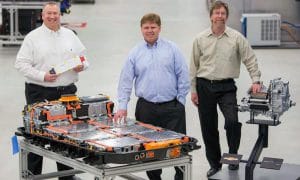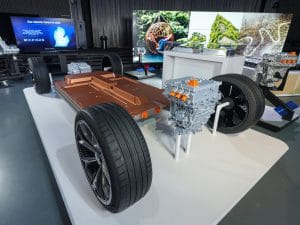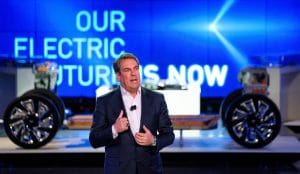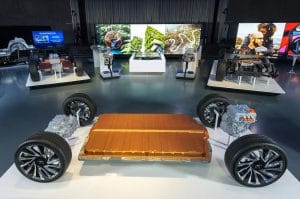
GM’s battery chief Tim Grewe, center, said the company is staying on track with the EV plans, including the introduction of the Cadillac Lyriq.
The auto industry has taken a hard hit from the coronavirus pandemic, sales plunging to recession levels, production disrupted and as many as a third of the products originally scheduled to debut this year pushed back, some into 2021.
The Cadillac Lyriq, the luxury brand’s first long-range battery-electric vehicle, was scheduled to take its bow this past spring but the unveiling now has been pushed back to August.
Despite that delay, the Lyriq will reach showrooms as originally scheduled next year, according to GM’s battery chief Tim Grewe, who told TheDetroitBureau.com in an exclusive interview that the automaker intends to stay on track with an aggressive program scheduled to bring 20 battery-electric vehicles to market by 2023, including not only the Lyriq but also the GMC Hummer pickup and a broad range of SUVs.
(Cadillac pulls plug on April debut of Lyriq due to coronavirus concerns.)
“The company has made this program a key priority,” said Grewe. “We have put safety procedures in place so we don’t experience delays” in the actual launch of upcoming BEVs. “I don’t see any reason why they should” fall behind schedule.

Before the pandemic hit, General Motors revealed its all-new modular platform and battery system, Ultium, to journalists.
GM was an early pioneer in electrification with its EV1, a limited-production model that generated a loyal following — but also sparked a serious backlash when the automaker wound up crushing all the cars on the road. It even served as the corporate bad guy in the film, “Who Killed the Electric Vehicle.”
The automaker earned a bit of a reprieve when, a decade ago, it launched the world’s first mass-market plug-in hybrid, the Chevrolet Volt, following six years later with the all-electric Chevy Bolt. But it has watched from the sidelines as rival Tesla has become the new darling of environmentalists and investors, Wall Street rewarding the California carmaker with a market capitalization many times that of GM and more, even, than that of Toyota, the most highly valued of traditional automakers.
GM CEO Mary Barra and her team are determined to catch up and, if anything, swamp Tesla with an array of electric vehicles that they’re betting Tesla won’t be able to keep up with. Back in March, shortly before pandemic lockdowns swept across America, the carmaker invited journalists in to see what it was working on. About half of the products due out by 2023 were put on display, some in near production-ready form, others little more than clay mockups.
The group covered a broad spectrum of the automotive market, from a compact Chevrolet hatchback up to full size pickups and SUVs. They targeted entry-level buyers, family customers and, in the case of the Cadillac Celestiq, those who could otherwise be looking at exotics in the Ferrari class.

Cadillac’s Lyriq will be its first long-range BEV, and should still hit dealerships next year, Grewe said.
The event also gave a first look at the new Ultium battery technology GM has developed in partnership with South Korean supplier LG Chem, and which it plans to start producing at a new factory in Ohio. Those lithium-ion batteries could determine whether the overall GM program is a success or failure.
(GM outlines EV plan to cover every brand, product segment and price range.)
There are a number of challenges GM faces with Ultium, Grewe said in his interview. Cost is arguably the biggest. When GM started producing the Chevrolet Volt PHEV, a kilowatt-hour of batteries cost about $1,000. When the Chevy Bolt debuted, that had dropped to around $145, GM officials confirmed. According to John Murphy, the well-respected Bank of America auto analyst, that needs to get below $100 per kWh before the retail price of a BEV can match that of a comparable gasoline-powered model.
“The cost side is improving” rapidly, Grewe said. “I can’t say we’re already reaching $100 but it’s happening quicker than I thought it would. Once we cross $100 it will keep going down.”
While he declined to say where the bottom end might be, some senior GM insiders, who have talked to TheDetroitBureau.com on background, have suggested the possibility of reaching a low of $70 before the likely next big breakthrough, solid-state batteries, can be ready for production. If that’s true, it would be possible to deliver extensive range, even while BEVs wind up becoming the affordable choice. How soon? Most industry analysts don’t see that happening, however, until the middle or later in the decade.
Range is the other major challenge. The EV1, in its day, could barely manage 50-70 miles on a charge. When BEVs like the Nissan Leaf came to market, 100 miles was the bogey. Tesla stood that on its head, initially targeting 200, then 300 and, just recently, announcing it will offer a 400-mile version of the big Model S sedan. GM has also promised that Ultium will let it reach 400 miles with some of its offerings. Like Tesla, it will also offer a choice of battery packs on different models.
In the battery world, range translates into “energy density,” the amount of power that can be stored in a given mass. “Power density” refers to how much energy you can push into the battery when charging, and then pull out when a driver puts pedal to the metal. Grewe stressed that GM expects to significantly up both of those metrics with Ultium. It is expecting, he noted, to deliver as much as 1,000 horsepower with the most powerful version of the Hummer pair.

GM President Mark Reuss told TheDetroitBureau.com the company wants to make it so its EVs can get a 90% recharge in 10 minutes or less.
Separately, GM President Mark Reuss told TheDetroitBureau.com back in March that the company is targeting the ability to eventually deliver a 90% recharge in as little as 10 minutes, which would be the first to get recharging into the timeframe of what it takes to fill a tank of gas.
“It’s hard to schedule innovation,” Grewe cautioned. But where battery researchers were routinely prone to overstating their results, he said, it is now just as common that improvements are coming faster than expected. It helps, he said, to be able to monitor what is happening in the real world, drawing data on how the batteries in Chevy Bolts are performing in real-time using onboard telematics. Tesla does much the same thing.
(GM’s next-gen EVs will be able to charge as fast as you can fill your gas tank.)
And this offers another advantage: being able to do things remotely. That’s a big advantage during the pandemic, said Grewe, one of the ways GM hopes will allow its BEV program to remain on schedule.

